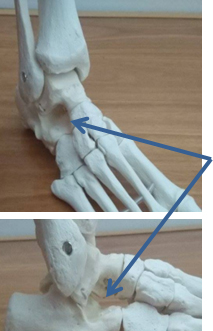The sinus tarsi, located on the outside of your foot near your ankle, is where two of your foot bones meet and form what appears as a bony tunnel. The sinus tarsi contains several structures including nerves, blood vessels, ligaments and fat.
contains several structures including nerves, blood vessels, ligaments and fat.
Sinus tarsi syndrome commonly occurs after ankle sprains which may have irritated and inflamed the ligaments and structures within the sinus tarsi. Alternatively, in people with feet that are structurally or functionally very rolled inwards, the structures within the sinus tarsi may become compressed or overused and so irritated.
Sinus tarsi syndrome is associated with a vague but significant description of pain on the outside of the foot and ankle. It is usually accompanied by swelling and often instability. The pain is worst when walking, especially on uneven surfaces.
Treatment from home:
- Place ice in a bag and wrap it in a tea towel. Use this to ice the area for 5-10 minutes several times a day.
- Talk to your doctor or podiatrist about your suitability to take or apply an anti-inflammatory medication or gel short term to reduce the inflammation.
- Wear stable shoes. Avoid high heels or cheap, flat shoes. A stable jogger is usually helpful.
Treatment from your podiatrist may include:
- A compression sock to reduce swelling and stabilise the foot and ankle
- An orthotic to improve abnormal foot posture or function which may have caused or contributed to the pain
- Footwear advice
- In unresponsive cases or cases not healing as quickly as expected, the podiatrist may refer you for an x-ray and/or ultrasound to rule out other possible causes of the pain.
- For a conclusive diagnosis in ongoing cases, a podiatrist may also refer for an anaesthetic injection. If pain ceases with injection, then this provides a positive diagnosis of sinus tarsi syndrome.
- As pain and swelling reduces, the podiatrist will introduce strength and balance exercises to rehabilitate your ankle strength and function.

Comments are closed.